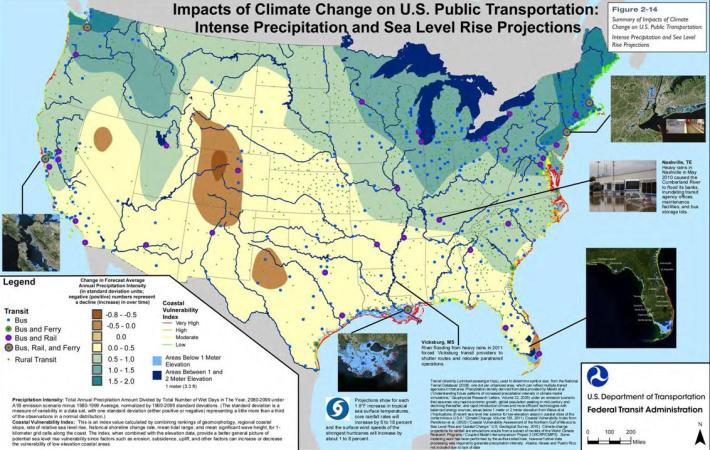Deron Lovaas is the Federal Transportation Policy Director for the Natural Resources Defense Council. This article is cross-posted from his blog on Switchboard.
The Boy Scout motto ("Be prepared") should guide state transportation departments (DOTs), metropolitan planning organizations (MPOs) and transit agencies as we recover from the destruction Hurricane Sandy wreaked. This superstorm was deemed historic for transit right off the bat by Chairman Joseph Lhota of the Metropolitan Transportation Authority (MTA): "The New York City subway system is 108 years old, but it has never faced a disaster as devastating as what we experienced last night."
The Federal Emergency Management Administration (FEMA) has already put thousands of "boots on the ground" to assess and address the damage to livelihoods, lives and property. As they do their jobs and FEMA taps into its multibillion-dollar fund for emergencies such as this, it's worth recalling advice the agency gives regarding prevention: Each dollar invested in hazard mitigation saves four dollars in avoided damage costs.
I learned this advice from a report prepared about a year ago by Tina Hodges when she was at the Federal Transit Administration (she recently moved down the hall to the much bigger Federal Highway Administration): "Flooded Bus Barns and Buckled Rails: Public Transportation and Climate Change Adaptation." It's one of several FTA resources that seem downright prescient right now, all available for download and perusal here.
There are some reports from assessment projects funded by FTA via grants, including one by the Southeastern Pennsylvania Public Transportation Authority (SEPTA). In fact, I saw a presentation about SEPTA and the Chicago transit agency assessments at a sustainability conference in Philadelphia a couple of months ago. MTA wasn't among the transit agencies funded to assess climate preparedness needs, because it's the pioneer (in collaboration with Columbia University, especially Professor Klaus H. Jacob) that examined the risks before any other agency.
Projjal Dutta at the MTA started right after Hurricane Irene hit the city, and his portfolio has been about climate preparedness since then (Andrea Bernstein wrote about his work with the MTA a year ago here). In addition to overall risk analysis for the system, such as this presentation from about a year ago -- which includes frighteningly familiar maps showing subway lines that could flood in sea-level-rise and storm-surge conditions -- Projjal has championed cheap and smart tactics for reducing the amount of storm water that could flood subway tunnels by elevating street grates so water flows around them, not through them and into subway tunnels (example below).
In her report, Tina also advocates for such "no-regrets" tactics as including green roofs and pervious pavement or landscaping that allows for infiltration rather than channeling of storm water into potential flood streams. Such tactics fit into the "protect" bucket she lays out of overall strategies for preparedness:
- Maintain and manage infrastructure;
- Strengthen and protect it;
- Enhance its redundancy; and/or
- Abandon it entirely in extremely vulnerable areas (e.g., unprotected coastal areas and floodplains).
These strategies are worth considering by transit agencies nationwide which face challenges due to increased and more intense weather events such as heat waves, heavy rainfall or droughts as well as sea-level rise. Tina points out that 10 percent of the land in 180 coastal municipalities lies merely a meter or less above the ocean. In San Francisco, sea level rise could well mean that today's 100-year flood is just the high tide of the future. FTA developed the map above to show where rainfall and sea changes intersect with transit systems.
Implementation of the new transportation law should reflect lessons being learned right now as we recover from Sandy. For example, state of good repair (SOGR) is a priority for all modes of transportation now, which will be reflected in new performance management systems being hammered out by DOTs, MPOs and transit agencies. It's hard to achieve and maintain SOGR without preparing for climate change, since any work could be wiped out by an extreme weather event unless infrastructure is hardened or adapted so it's well-protected. So climate preparedness should be part and parcel of the definition of SOGR.
And Tina recommends, as I know Projjal and another friend Steve Winkelman at the Center for Clean Air Policy (who wrote a solid post on lessons from Sandy here) do as well, that preparing for climate change be something that DOTs and MPOs address in their long-range planning process. This is a good time for transit agencies to engage, since the new law requires that they have a seat on MPO boards. Now is the time for MPOs to review long-range plans with new lenses, ones shaped by the amazing and terrible news and images from New Jersey and New York this week.
Governor Chris Christie and President Obama have set aside politics and plunged into the monumental tasks confronting the east coast in Sandy's aftermath. DOTs, MPOs and transit agencies should take a cue from our leaders by collaborating so we can be prepared for stormier roads up ahead. Let's get to work.






